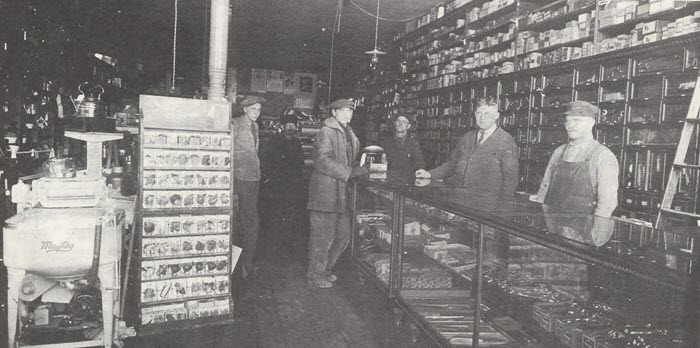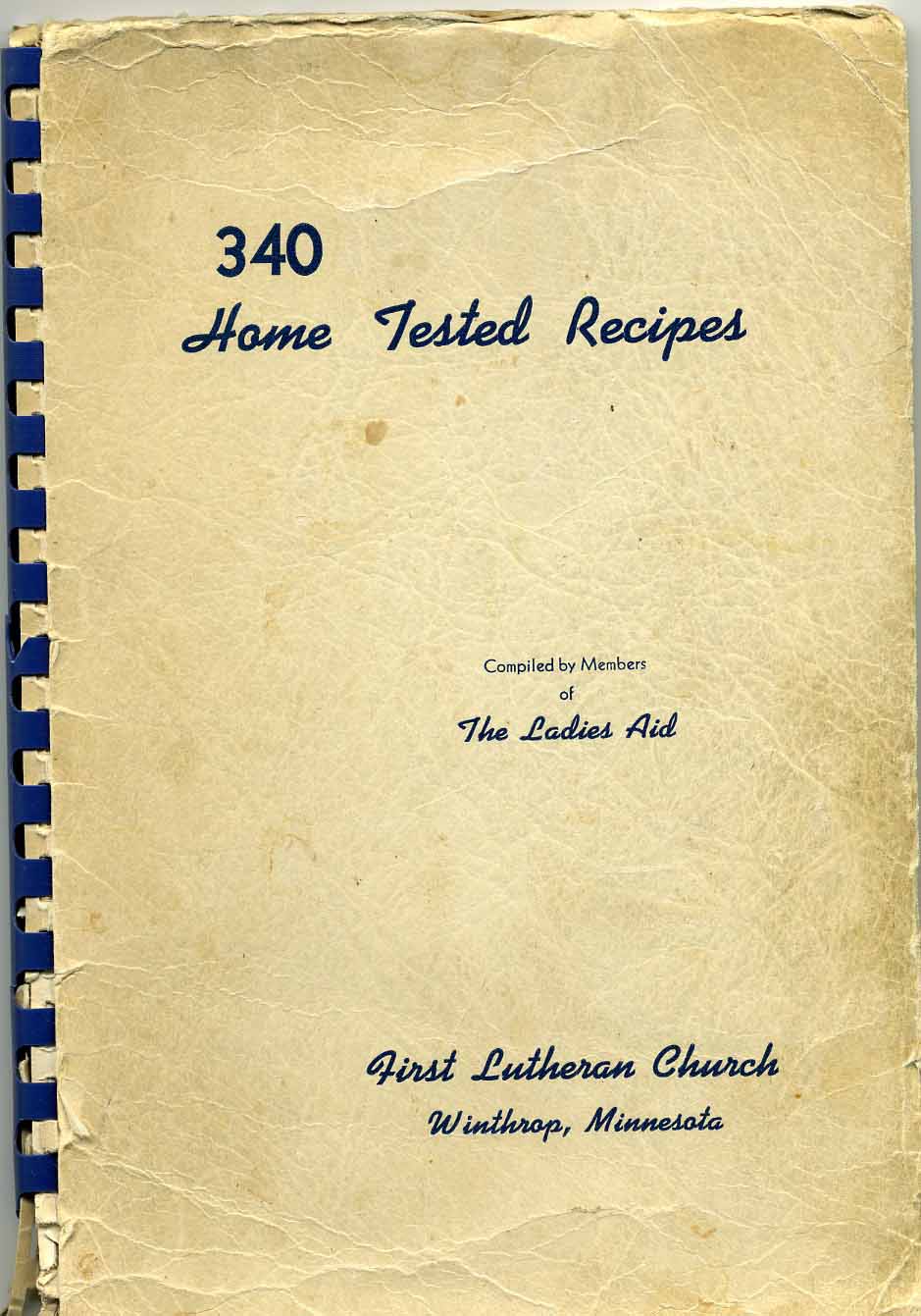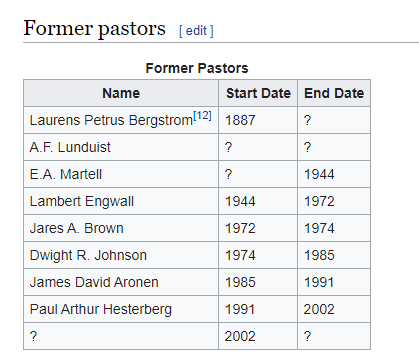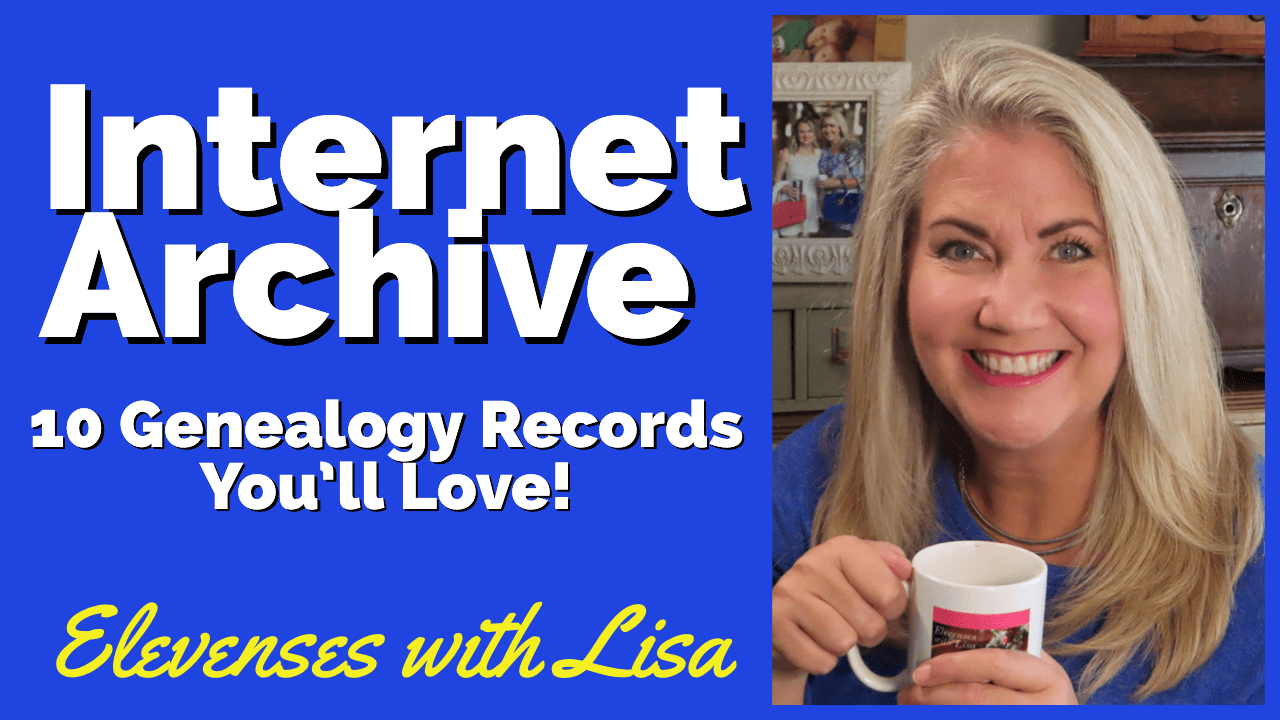Family History Never Tasted So Good!
We all have cookbooks in our kitchen, many of which were handed down to us by our mothers and grandmothers. In addition to be overflowing with delectable recipes, they are often brimming with family history. Today I’d like to share with you a recipe mystery that followed me for years, and the bit of genealogical serendipity that solved it.

I once gave a presentation called Inspiring Ways to Capture the Interest of the Non-Genealogists in Your Family at a local genealogical society. (Genealogy Gems Premium Members can log in and watch this vide class as part of their membership here.)
In it, I gave an example of some items I had found on Ebay from my husband’s Larson family. If you listen to the Genealogy Gems Podcast then you have heard me mention the Larson family. They hailed from Winthrop Minnesota and owned a hardware store and lumber business there for many years.

LJ Larson Hardware store
While I was taking questions toward the end of the presentation a woman in the front raised her hand. Her name was Harriet, and she said she was sure that she had a cookbook from Winthrop, Minnesota in her collection of books at home. She offered to send it to me and I gladly gave her my email address so we could connect.
Considering that Winthrop is such a small town, it make her statement surprising indeed! To provide perspective: Winthrop is about 1 square mile and the population hovers somewhere around 1300. So, I was surprised indeed to have someone in Pleasanton, California telling me that she had a cookbook that dated back to the early 20th century from this little town.
As promised, Harriett followed up with me by email. She asked for my address and told me that the book “looks a little worn but all of the pages are there. I hope it can be of some use to you. My sister taught either first grade or kindergarten there during World War 2 and that’s how it came in to her possession.”
The Cookbook Filled with Family History
Harriett was a woman of her word because about a week later the 340 Home Tested Recipes cookbook compiled by members of The Ladies Aid of the First Lutheran Church of Winthrop, Minnesota was in my mailbox.

The Winthrop Cookbook
It continues to amaze and delight me how powerful just putting your family history “out there” is. By regularly mentioning real people and places in your own research, it so often leads to information and items that just seem to be waiting to be found. It’s what we call “genealogical serendipity” in genealogy circles.
But the genealogical serendipity didn’t end there. Not only did my husband’s ancestors contribute recipes to this little community cookbook, which of course I was thrilled to find – but there was a recipe in there that I had been in search of for over 25 years.
The Great Cookie Mystery
You see, when Bill and I got married, he shared his fond memories of a sour cream cookie his grandmother used to make. I’m an avid baker, so I checked with his mom to see if she had the recipe. Sadly, she didn’t.
Over the years I have tried to find a recipe for sour cream cookies in an attempt to recreate them. Every time I found one, I whipped up a batch. Bill would take a bite and shake his head saying they’ were good, but they weren’t like grandma’s cookies.

Bill enjoying baked treats with his Grandma Helen (Larson) Mansfield.
So as you can imagine, the first thing I looked for when I received this cookbook from the town where Bill’s grandma was born, was a recipe for sour cream cookies. There were many yummy-sounding treats to comb through like Pecan Sticks, Victoria Cookies, Father and Son Favorite Cookies, and Sorghum Cookies.
I got excited as I came across names I recognized from the family tree including Mrs. Sheldon S. Larson, the mother of a cousin we had the good fortune to finally meet two years ago when I presented a genealogy seminar in Minnesota at the Swedish Genealogical Society.
But the real thrill came when I made my way to page 42. There I found a recipe for Sour Cream Drop Cookies:

The infamous sour cream cookie recipe!
Surprisingly, the recipe wasn’t contributed by Bill’s grandma Helen (Larson) Mansfield or anyone named Larson. Instead it was submitted for inclusion in the cookbook by Mrs. Hulda Anderson. That fact didn’t deter me from trying it out. In a small town like Winthrop, recipes likely were regularly swapped and handed down through various families.
I immediately baked a batch and served them up to Bill. I’ll never forget his eyes as they lit up in excitement! He took a bite, and was ecstatic to once again be tasting Grandma’s sour cream cookies!
It may sound like a small victory in the scheme of thing, but for me it was a thrilling one, none the less!
I emailed Harriet and told her the good news and thanked her profusely.
I got a reply from her husband George. He wrote:
“I thought I would add a little amusement to the coincidence of the Sour Cream cookies. My father, George Anderson, Sr., was a salesman for American Steel and Wire, subsidiary of U. S. Steel, from the 1920s to the 1960s, traveling to every hardware store and lumber yard in southern Minnesota to sell fence, posts, nails etc. I don’t have any record of it, but I’m sure he would have called on your family’s hardware store in Winthrop. He knew all of his customers by first name, no doubt your in-laws included.”
Genealogy Serendipity never tasted so good!
A Genealogical Look at the Cookbook
I looked through the book carefully for a publishing date but none was to be found. However, there were several clues including the name of the church and the pastors name:
First Lutheran Church
Lambert Engwall, Pastor
To put these clues to use, I headed to Google and searched the name of the church, the location and the name of the pastor:
first lutheran church winthrop minnesota lambert engwall, pastor

Googling the church, location and pastor
The first result was just what I needed. The link to me to a Wikipedia page about the church:

The church in Wikipedia
It was a fairly comprehensive page, and I was specifically looking for a list of pastors who had served at the church. To save time, I used Control + F (PC) to trigger a find on page search bar. I searched for “pastor” and was immediately take much further down the page to exactly what I wanted to know.

A helpful list of previous pastors
I quickly learned that Lambert Engwall served at this church in Winthrop, Minnesota from 1944 to 1972. Given that Harriett through it hailed from the World War II era when her sister lived there, and from the condition and style of the book, I feel confident it was published closer to 1944.
The next steps to learn more about the relationship between the Andersons and Larson include could include:
- Reviewing the 1940 census for Winthrop, Sibley County, Minnesota, and mapping their homes in Google Earth.
- conducting additional research into church and their available records include church meeting minutes.
- A comprehensive search of the Winthrop News newspaper, with a particular eye on the social pages.
Share Your Genealogical Serendipity and Cookbook Stories
Have you experienced glorious instances of genealogical serendipity in your own family history quest? Do you have a cookbook that has been handed down to you that you treasure? Please leave a comment below and share your story!
Resources
- Learn more powerful Google search techniques and ways to use Google Earth for genealogy in The Genealogist’s Google Toolbox by Lisa Louse Cooke (2020) available at the Genealogy Gems Store.
-

Book by the author
Learn more here about how to access the 50+ video classes that are a part of Genealogy Gems Premium membership.
Old Cookbooks Are Among New Online Record Collections
Old cookbooks are among new recent online records collections. So are British newspapers, British Columbia estate files, New Zealand WWII appointments, UK Parliamentary returns, UK military indexes, US newspapers (Arkansas, Kansas, and New York) and church records for Sydney, Australia; Norfolk, England; and Stockholm, Sweden.

Featured New Records Online: Old Cookbooks and Home Remedies
 The US National Library of Medicine has “recently embarked on a project to digitize and make available” its collection of historical recipes and cookbooks, according to its blog. Old recipes (also called “receipts”) may give you a glimpse into what daily life was like for your ancestors. Among these are “recipes and advice for food preparation and preservation, animal husbandry, preparing useful household concoctions, and allopathic medicines and treatments for maintaining personal health.” Find these at the National Library of Medicine Digital Collections.
The US National Library of Medicine has “recently embarked on a project to digitize and make available” its collection of historical recipes and cookbooks, according to its blog. Old recipes (also called “receipts”) may give you a glimpse into what daily life was like for your ancestors. Among these are “recipes and advice for food preparation and preservation, animal husbandry, preparing useful household concoctions, and allopathic medicines and treatments for maintaining personal health.” Find these at the National Library of Medicine Digital Collections.
Love these? Click here to find more old recipes and classic cookbooks on the Genealogy Gems website.
Australia – New South Wales – Church records
Nearly 125 years of baptism, marriage, and burial registers for the city and parish of Saint Peter’s in the greater metropolitan area of Sydney, Australia (1839-1963) are now available on Ancestry.com. Baptismal registers may include the child’s name, birth and baptismal dates, parents’ names, abode and profession of parent(s) and officiant’s name. Marriage records may list for bride and groom the names, occupations, residences, ages and marital status, along with the date and place of the wedding, names of those giving consent (if required) and the officiant. Burial registers may mention the name of the deceased; death and burial dates; abode; age; “quality” or profession, and officiant.
Britain – Dougal’s Index Register
A Findmypast.com collection of Britain’s missing beneficiaries and unclaimed estates (1910) “contains over 500 records from Dougal’s Index Register to Next of Kin, Heirs at Law and Cases of Unclaimed Money Advertisements from 1910. The publication looks specifically at properties or estates registered in chancery court, which have gone unclaimed because a deceased person did not create a will or did not have any known descendants….The lists only provide an individual’s first and last name.”
Britain – Newspapers
Over 48,000 new articles and two brand new titles have been added to Findmypast’s collection of historic British newspapers. This month’s new titles are The Shipping & Mercantile Gazette and The Rutland Echo & Leicestershire Advertiser.
Canada – British Columbia
Findmypast.com subscribers may now browse among over 750,000 records of British Columbia Estate Files (1859-1949). According to the site, these “allow you to delve through probate estate files pertaining to the judicial districts of British Columbia; the County Court and the Supreme Court. Probate estate records are a valuable resource for family history research, providing vital details such as dates, names, and locations to help grow your family tree. Included in this collection is a probate index for the district of Vancouver, sorted alphabetically by last name.” Browsing tip: narrow results by year, document, court, and district.

Canada celebrated its 150th birthday in 2017! Click here to read tips for starting your Canadian research from Lisa Louise Cooke’s conversation with Library and Archives Canada staffer Claire Banton.
England – Norfolk parish records
Fifty-one volumes of Norfolk Archdeacon’s Transcripts (1600-1812) and 123 volumes of Bishop’s Transcripts (1687-1901) are now browseable at Findmypast.com. According to the site, the collections contain records of baptisms, marriages, and burials from across the county.
New Zealand – WWII
Fold3.com hosts a new collection of WWII Appointments, Promotions, Transfers and Resignations, extracted from the New Zealand Gazette. These give information such as name, rank, event date, and regiment for members of the New Zealand Expeditionary Forces (including army, air force, and navy).
Sweden – Stockholm
Nearly 175,000 indexed names and over 14,000 digital images were recently added to a free collection at FamilySearch.org: Sweden, Stockholm City Archives, Index to Church Records (1546-1927).
UK – Military
Ancestry.com has published a new collection of UK Military Indexes, 1920-1971. According to the site, “These lists comprise the names and service numbers of those who were discharged from the armed forces after 1920 and born before 1901. Details given for over 300,000 individuals found within this collection may include (where available): initial and surname, date of birth, their service, service number and Ministry of Defence reference number.”
UK – Parliamentary Returns
The UK Parliamentary Archive has “recently uploaded the Protestation Returns for Berkshire, Cornwall and Cumbria,” according to its blog. “The Protestation Returns are the closest thing we have to a census for England in 1641-1642. They originate in the scuffling between Parliament and Charles I just before Civil War engulfed the country. It was decided that all men over the age of 18 in England and Wales should swear an oath of allegiance to the Protestant religion, Parliament, and the King. Around one-third of the records for England survive.” A companion map allows users to search for these records by location.
US – Arkansas, Kansas, New York – Newspapers
Among new digitized newspaper collections at Newspapers.com are the following titles: The Frankfort Bee (Kansas, 1876-1898), The Southern Standard (Arkadelphia, Arkansas, 1878-1905), Arkansas Times and Advocate (Little Rock, 1837-1838), Cortland Register (Kansas, 1889-1924), The Frankfort Sentinel (Kansas, 1886-1892), The Marshall County Index (Frankfort, Kansas, 1905-1906), Epworth Advocate (Frankfort, Kansas, 1895-1896), Springville Journal (New York, 1867-1985) and The Ness County Pioneer (Sidney, Kansas, 1879-1880).
Are you listening to the free Genealogy Gems Podcast? This year Lisa Louise Cooke celebrates 10 years on the air. The show has more than 2.5 million downloads worldwide. Listen to hear for yourself her winning combination of technology tools, genealogy research strategies, inspiring stories–and tons of tips you can apply right away to your family history!

Disclosure: This article contains affiliate links and Genealogy Gems will be compensated if you make a purchase after clicking on these links (at no additional cost to you). Thank you for supporting Genealogy Gems!
Ultimate Guide to 1890 Census and Substitute Records
Video & Show Notes
Click the video player to watch episode 54 of Elevenses with Lisa about the 1890 census and substitute records. Below you’ll find the detailed show notes with all the website links I mention. Premium Members will find the downloadable ad-free PDF cheat sheet of these show notes at the bottom of this page in the Resources section, along with my BONUS 1890 Census Gap Worksheet.
What Happened to the 1890 Census
The census shows us our ancestors grouped in families, making it a valuable resource for genealogy. Soon the 1950 census will be available, but for now the most current census publicly available in 1940. In it we may find, depending on our age, ourselves, our parents, our grandparents, and our great parents. In many cases it’s quick and rewarding to make your way back in time to the 1890 census which was taken starting June 1, 1890. And that’s where the trail hits a bump. In January 1921 a large fire broke out in the Commerce Building in Washington DC where the 1890 census records were stored, and most were destroyed as a result. Only 6,160 individual names remain in the remnants. (Learn more about the destruction of the 1890 census at the National Archives.)
Prior to the 1890 U.S. Federal Census, the last census taken was in 1880. With about 99% of the 1890 being destroyed as the result of the fire, this leaves a 20 year gap in the census (1880 – 1900.)
Much can happen in a span of twenty years. For example, your ancestors could have been born and reached adulthood. Filling in their timeline for this period requires a bit more effort, but the results are worth it.
In this video and article we’ll cover:
- How to find the remaining fragments of the 1890 population enumeration
- What you can learn from the 1890 census records
- Lesser known 1890 census schedules that can still be found.
- The best 1890 substitute records and how to find them.
Surviving 1890 Federal Census Population Schedules
A very small portion of the 1890 census has survived, but it’s more than just the population schedule. Here are the six types of records still available.
1. 1890 Federal Population Schedule Fragments
How to find the records:
- Fragments of the 1890 Federal Census covering just 6160 individuals managed to survive and are available online at Ancestry.
- Browse the 1890 Census fragments at FamilySearch.
- Searchable index for 1890 census at FamilySearch.
List of the locations covered by the surviving 1890 federal census:
Alabama: Perryville Beat No.11 (Perry County) and Severe Beat No.8 (Perry County)
District of Columbia: Q Street, 13th St., 14th St., R Street, Q Street, Corcoran St., 15th St., S Street, R Street, and Riggs Street, Johnson Avenue, and S Street
Georgia: Columbus (Muscogee County)
Illinois: Mound Township (McDonough County)
Minnesota: Rockford (Wright County)
New Jersey: Jersey City (Hudson County)
New York: Brookhaven Township (Suffolk County) and Eastchester (Westchester County)
North Carolina: South Point and River Bend Townships (Gaston County), Township No. 2 (Cleveland County)
Ohio: Cincinnati (Hamilton County) and Wayne Township (Clinton County)
South Dakota: Jefferson Township (Union County)
Texas: J.P. No. 6, Mountain Peak, Ovilla Precinct (Ellis County), Precinct No. 5 (Hood County), No. 6 and J.P. No. 7 (Rusk County), Trinity Town and Precinct No. 2 (Trinity County), and Kaufman (Kaufman County)
Questions Asked in the 1890 U.S. Federal Census
The following questions were asked by the census taker:
- Name
- Age
- Sex
- Address
- Number of families in the house
- Number of persons in the house
- Number of persons in the family
- Relationship to head of family
- Race: white, black, mulatto, quadroon, octoroon, Chinese, Japanese, or Indian
- Marital status
- Whether married during the year
- Total children born to mother
- Number of children living
- Birthplace
- Birthplace of parents
- If foreign born, how many years in the United States
- Naturalized or in the process of naturalization
- Profession, trade, or occupation
- Months unemployed during census year
- Able to read and write
- Speak English; if not, language or dialect spoken
- Suffering from acute or chronic disease (if so, name of disease and length of time afflicted)
- Defective in mind, sight, hearing, or speech
- Crippled, maimed, or deformed (with name of defect)
- Prisoner, convict, homeless child, or pauper
- Home is rented or owned by the head or a member of the family
- (if so, whether mortgaged)
- Head of family a farmer, if he or a family member rented or owned the farm
- If mortgaged, the post office address of the owner
2. Schedules for Union Soldiers & Widows
According to the National Archives, “The U.S. Pension Office requested this special enumeration to help Union veterans locate comrades to testify in pension claims and to determine the number of survivors and widows for pension legislation. (Some congressmen also thought it scientifically useful to know the effect of various types of military service upon veterans’ longevity.) To assist in the enumeration, the Pension Office prepared a list of veterans’ names and addresses from their files and from available military records held by the U.S. War Department.
Index and images of schedules enumerating Union veterans and widows of veterans of the Civil War for the states of Kentucky through Wyoming. Except for some miscellaneous returns, data for the states of Alabama through Kansas do not exist. Some returns include U.S. Naval Vessels and Navy Yards. The schedules are from Record Group 15, Records of the Veterans Administration and is NARA publication M123.
Nearly all of the schedules for the states of Alabama through Kansas and approximately half of those for Kentucky appear to have been destroyed before transfer of the remaining schedules to the National Archives in 1943.”
How to find the records:
Search the United States Census of Union Veterans and Widows of the Civil War, 1890 (index & images) at FamilySearch.
These records can tell you:
- State, county and district where census was taken
- Date census was taken
- Full name of surviving soldier, sailor, marine, or widow
- Rank, company, regiment or vessel
- Date of enlistment
- Date of discharge
- Residence
- Disability
- Length of service in years, months, and days
- Remarks
Learn more:
- U. S. Gen Web features a map showing what’s available.
- See the census form used for the United States Census of Union Veterans and Widows of the Civil War, 1890 at the National Archives.
- Read the official National Archives pamphlet at Fold3 explaining The Special Schedules of the Eleventh Census (1890) Enumerating Union Veterans and Widows of Union Veterans of the Civil War. (M123.118 rolls)
3. Schedules Oklahoma Territories
The 1890 Oklahoma Territorial Census lists people who lived in the Oklahoma Territory. The seven counties making up the Oklahoma Territory at the time are listed below. Note the number as they were often listed only by these number on the census.
- Logan County
- Oklahoma County
- Cleveland County
- Canadian County
- Kingfisher County
- Payne County
- Beaver County
How to find the records:
- Oklahoma Historical Society – Search the 1890 Oklahoma Territorial Census for free. Order copies of print or digital records for a fee.
- Ancestry – Search Oklahoma, U.S., Territorial Census, 1890 and 1907 and retrieve the digitized images. (Subscription required)
4. Selected Delaware African American Schedule
One of the primary uses of the census by the government is to compile statistical reports using the data gathered. Many of these can be found online at places like Google Books.
The Delaware African American Schedule came about because of one of these statistical reports. According to the National Archives, in 1901 the Chief Statistician for Agriculture wrote a report about agriculture in the state of Delaware. Just before it was to be published, some of the conclusions reached in the report were disputed. The controversy centered around what was then referred to as “Negro” farmers. The results was that additional research was conducted in an effort to find all “Negro” farmers in the 1890 and 1900 Delaware census records. The dust up over the statistical report was fortunate indeed because these records are now available.
How to get the records:
- Ancestry – Search the Delaware, U.S., African Americans in 1890 U.S. Census collection and retrieve the digital record images. (Subscription required.)
- National Archives – Learn more at 1890 Census, Delaware.
The list is roughly in alphabetical order according to surname and contains the following information:
- Name
- Census Year
- Enumeration District (ED) Number
- ED Description (locality and county)
- Occupation
5. Statistics of Lutheran Congregation & Statistical Information for the U.S.
These record collection offers limited usefulness because they don’t name people. However, if you have questions about Lutheran ancestors around 1890 or would like more contextual information about the time period, they might be worth a look.
Statistics of Lutheran Congregation reproduces a list of each Lutheran church or local organization compiled by the Census Office from information submitted by officials of the Lutheran officials.
How to find the records:
The National Archives – Contact the National Archives regarding National Archives Microfilm Publication M2073, Statistics of Congregations of Lutheran Synods, 1890 (1 roll). Records are arranged by synod, then state, then locality.
For each church or local organization, the following information is given in seven columns:
(1) town or city
(2) county
(3) name of organization
(4) number or type of church edifice
(5) seating capacity
(6) value of church property
(7) number of members.
6. Statistical information for the entire United States
Statistical reports were compiled and analyzed by the Census Office after the 1890 census was completed. These massive statistical reports are available in National Archives Microfilm Publication T825, Publications of the Bureau of the Census.
How to find the records:
Google Books – Some of the statistical reports have been digitized and are available for free on Google Books. One of the most interesting is the Report on the Social Statistics of Cities in the United States at the Eleventh Census: 1890.
Best Substitute Records for the 1890 Census
Now that we’ve scoured every inch of available records remaining from the 1890 U.S. Federal Census, it’s time to go on the hunt for substitute records. We’ll be focusing on the best available and easiest to find resources.
1885 & 1895 State Census Records:
The U.S. federal government was not alone in taking the census. Some states also took their own state census. These were usually conducted in the years between the federal censuses, most commonly on the “5” such as 1875, and 1885. You may find some as far back as 1825 and as recent as 1925, as in the case of the state of New York.
How to find the records:
Look for state census records at state archives, state historical societies, and state libraries. Many are also conveniently searchable online, most commonly at FamilySearch (free) and Ancestry (subscription.)
Arizona, U.S., Territorial Census Records, 1882 (Ancestry)
Kansas 1895 (FamilySearch)
Kansas 1895 (Kansas State Historical Society)
Colorado State Census 1885 (FamilySearch)
Colorado State Census 1885 (Ancestry)
Michigan State Census 1894 (FamilySearch)
Michigan State Census 1894 (Ancestry)
Minnesota State Census 1885 (FamilySearch)
Minnesota State Census 1895 (FamilySearch)
Minnesota Territorial and State Censuses 1849 – 1905 (Ancestry – select year, then county)
Minnesota Territorial Census records from 1849, 1850, 1853, 1855, and 1857 and Minnesota State Census records from 1865, 1875, 1885, 1895 and 1905 (Minnesota Historical Society)
Florida State Census 1885 (FamilySearch)
Florida State Census 1885 (Ancestry)
Iowa State Census, 1885 (FamilySearch)
Iowa State Census, 1885 (Ancestry)
More on the Iowa 1885 and 1895 censuses from the Iowa Data Center
Iowa State Census 1895 (FamilySearch)
Iowa State Census 1895 (Ancestry)
Nebraska State Census 1885 (FamilySearch)
Nebraska State Census 1885 (Ancestry)
New Jersey State Census 1885 (FamilySearch)
New Jersey State Census 1885 (Ancestry
New Jersey State Census 1895 (FamilySearch
New Jersey State Census 1895 (Ancestry)
New York State Census 1892 (FamilySearch)
New York State Census 1892 (Ancestry)
New York City Police Census 1890 (FamilySearch)
New York City Police Census 1890 (Ancestry)
Rhode Island State Census 1885 (FamilySearch)
Rhode Island, U.S., State Censuses, 1865-1935 (Ancestry – Filter by year then county)
Wisconsin State Census, 1885 (FamilySearch)
Wisconsin State Census 1895 (FamilySearch)
Wisconsin, U.S., State Censuses, 1855-1905 (Ancestry)
Missouri, U.S., State Census Collection, 1844-1881 (Ancestry – Filter by year then county)
Missouri, U.S., State Census Collection, 1844-1881 (FamilySearch)
South Dakota, U.S., Territorial Census, 1885 (Ancestry)
South Dakota, U.S., Territorial Census, 1895 (Ancestry)
Lisa’s Pro Tip: Get a Bit More with Mortality Schedules
Do you happen to have someone in your family tree who was alive and well in the 1880 census but nowhere to be found in the 1900 census? Official death records may not have been available during this time frame where they lived, compounding the problem.
The U.S. Federal Censuses from 1850-1880 included a mortality schedule counting the people who had died in the previous year. Since the 1880 census began on June 1, “previous year” means the 12 months preceding June 1, or June 1 (of the previous year) to May 31 (of the census year).
Ancestry has a database of these schedules which fall just before the 20 year time frame we are trying to fill. However, this collection also happens to include Mortality Schedules from three State Censuses: Colorado, Florida and Nebraska. There were conducted in 1885. They weren’t mandatory so there are only a few, but if you happen to be researching in one of these states, you just might get lucky.
How to find the records:
- U.S., Federal Census Mortality Schedules, 1850-1885 for Colorado, Florida & Nebraska. (Ancestry / $)
While you’re searching, be aware that not all of the information recorded on the census is included in the searchable index. This means that it is important to view the image and don’t just rely on the indexed information.
Ancestry 1890 Census Substitute Database
Ancestry has compiled a special searchable collection of records that can be used to fill in the gaps left behind by the loss of the 1890 census. It includes state census collections, city directories, voter registrations and more.
How to find the records:
- Search the 1890 Census Substitute at Ancestry
- See the complete list of collections
Find More 1890 Census Substitute Records at Ancestry
This substitute collection is a tremendous help, but don’t stop there. You can also manually hunt for substitute records to see if there might be something helpful that is overlooked in the 1890 census substitute search. This works particularly well if you have a specific research question in mind.
You might be wondering, why would I need to search manually? Many people rely on Ancestry hints to alert them to applicable records, and they figure the search engine will find the rest.
This is a mistake for two reasons.
- only approximately 10% of Ancestry® Records Appear as hints.
- Not all records at Ancestry are indexed and therefore searchable. There are thousands of browse-only digitized records. Read my article How to Find and Browse Unindexed Records at Ancestry – The Better Browsing Checklist.
- There may be a record that meets your needs that was not captured in the 1890 Census Substitute Collection. Try going directly to the Card Catalog and filtering to USA and then by decade such as 1890s.
FamilySearch 1890 Census Substitutes
While FamilySearch doesn’t have one massive substitute database, you can find several focused 1890 census substitute collections available online, at Family History Centers around the country and world, and in book form at the Family History Library in Salt Lake City.
How to find the records:
1. Go to FamilySearch
2. Log into your free account
3. In the menu go to Search > Catalog
4. Click Titles
5. Search for 1890 census substitute
6. If desired, filter down to records available or at a Family History Center near you.
City Directories as an 1890 Census Substitute
Some of the best and most comprehensive substitute records are city directories. If published in your ancestor’s area when they lived there, they can offer a year-by-year record. And that can do wonders for filling in the gap between the 1880 and 1800 census.
How to find the records:
You can find city directories at the big genealogy websites like Ancestry, MyHeritage and FamilySearch, as well as state archives, historical societies and libraries. Google searches also come in very handy in unearthing lesser known websites and repositories. Two of my favorite places to look that are both free and online are Google Books and Internet Archive.
- Google Books
Search for the state and county. On the results page click the Tools The first option in the drop-down menu will be Any View. Change it to Full View. The third option is Any Time. Click the down arrow and select Custom Range and set it to 1880 through 1890.
Episode 30: Lisa’s 10 surprising things to find at Google Books
- Internet Archive

Watch episode 43 on the Internet Archive.
Like Google Books, the Internet Archive has a vast array of materials digitized and available for free. Watch Elevenses with Lisa episode 43 for ideas and search strategies.
- US City Directories Collection at Ancestry ($)
Finding More 1890 Census Substitutes Online
We’ve touched on some of the most popular and helpful records that can be used to fill in the gap left by the loss of the 1890 U.S. Federal Census. As you expand your search look for:
- County histories
- Land records
- Maps (plat and insurance maps)
- Newspapers
- Probate records
- Tax records
- Voter registers
Resources
- Watch past free episodes of Elevenses with Lisa
- Get your official Elevenses with Lisa mug
- Subscribe for free to our Genealogy Gems YouTube channel so you’ll never miss another episode.
- Subscribe to my free email newsletter to get notifications.
- Bonus Download exclusively for Premium Members: Download the show notes handout. (Not a Premium Member? Become a Genealogy Gems Premium Member today.)
- BONUS 1890 Census Gap Worksheet (Premium Membership required)
Watch Next
Learn more about 1950 U.S. Federal Census Records. Watch episode 51 and episode 53.

Watch episode 51
Did you enjoy this episode? Have a question for Lisa?
You’re part of the family, so please leave a comment below!


